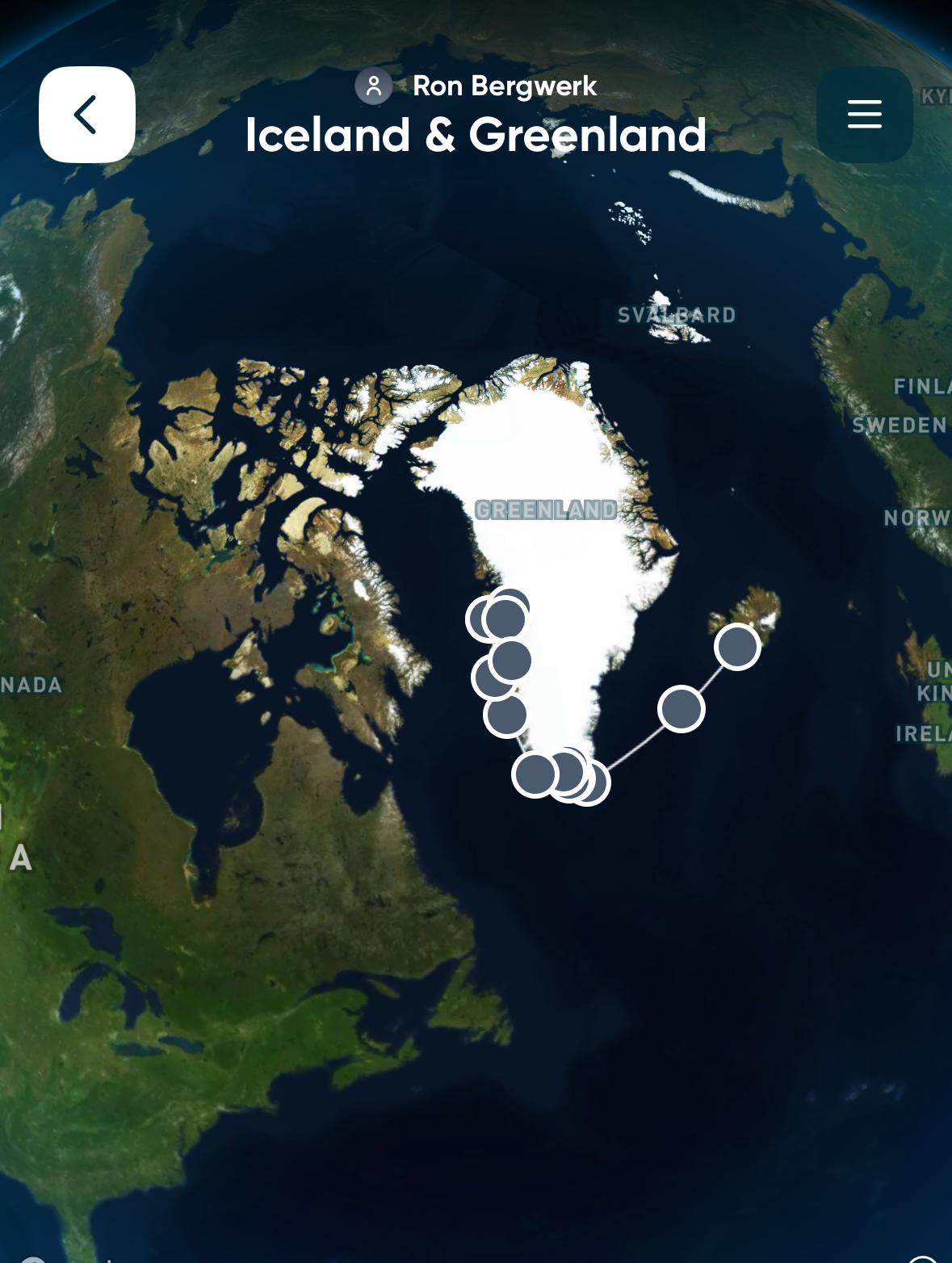
It's not a country, per se, but it is the largest "white spot" on most travelers' maps. Overlayed on North America it would stretch from Canada to Mexico. The world's largest island, it is basically uninhabited save for small coastal communities accessible only by air and sea.
The voyage is marketed as “In the Wake of Eric the Red,” named for the Viking who discovered and first settled Greenland. The ship, the Ocean Albatros, is a polar expedition vessel owned by a Danish company. About half of the 133 passengers are Danish.

Departure is from Reykjavík, Iceland
|
|
|
|
|
We board. Nice ship. Nice cabin.
|
|
|
|
|
The plan is to sail across the Denmark Strait (oddly enough, separating Iceland and Greenland and nowhere near Denmark; for WWII buffs, the Denmark Strait is where the battleship Hood was sunk by the Bismark) to visit the eastern coast of Greenland. However, the weather does not cooperate. A fierce storm with hurricane-force winds at its center is raging. The captain changes course and steers to skirt the worse of the storm and head for protected waters in the south.

We spend two days traversing 20 ft seas. Although the ship is equipped with computer-controlled stabilizers that minimize rocking, more than a few of the passengers are, quite literally, “under the weather”. For those still ambulatory, there are informational briefings where we learn, among other things, that polar bears are annoyed by penguins clanging cymbals.

Towards sunset on the third day we enter the narrow channel of Prins Christian Sund. The improvement is dramatic. Calm waters and our first view of glaciers and floating ice. As the sun lowers, the already blue appearance becomes more pronounced.
|
|
|
|
|
The next morning we wake up to glorious weather, which luck would have it, holds for the remainder of the voyage. Our first landing is at a place called Uunartoq, where there is a tiny settlement, a hot springs pool, and a rather pointless hike up a hill. This being polar bear country, our guides carry rifles, but even the ursines are too bored to bother us. (Joke: What should you do if you get lost in a Greenland forest? Stand up.)

The transfer from ship to shore is by Zodiac inflatable boats. The ship is equipped with twenty of them.

Afterwards we ride around the floating ice in Zacharias Havn.
|
|
|
|
|
The next day we land at Qassiartuk, the site of Eric the Red’s farm. He was exiled from Iceland in the year 982 and sailed east into the unknown. In a marketing play to encourage prospective settlers, he called the landmass he encountered Greenland. A longhouse and the first church have been reconstructed on the site.
|
|
|
|
|
On a hill overlooking the modern town (resettled in 1924, current population 62) is a statue of his son, Lief Ericsson, the “first” discover of America. The story goes that, in the year 1000, on his way back from Norway he was blown off course and ended up in “Vinland” in present-day Newfoundland.
|
|
|
|
|
On to Nuuk, the capital. About one-third of Greenland’s roughly 50,000 inhabitants live here. Like everyplace else, it used to have a (sort of) pronouncable Danish name (Gothåb). It was founded in 1728 by the missionary Hans Egede, whose statue overlooks the town.
|
|
|
|
|
It is home to the excellent National Museum.
|
|
|
|
|
What's the next best thing to shrunken heads? Mummies! Freeze-dried for our viewing pleasure.
|
|
|
|
|
After another sea day steaming north, we arrive at Disko Bay and the town of Qeqertarsuuq.
|
|
|
|
|
Its modest claim to fame is the world’s northernmost soccer pitch.
|
|
|
|
|
The native language, Greenlandic, features long words and a lot of Q's and U's, except that here the U's come before the Q's.

Later that day we cruise to the glacier Eqip Seremia and tour the bay in Zodiacs. It is hard to convey its size, but we are three miles distant from its face.
|
|
|
|
|
Next is Ilulissat There’s not much to see in town, but hiking trails and a boardwalk provide various vantage point of the icefjord for which it is famous.
|
|
|
Small arctic flowers mark the route.
|
|
|
|
|
|
|
Then, a boat ride in the icefjord among the many icebergs calved from Sermeq Kujalleq, the most active glacier in the world. The berg that sank the Titantic likely originated here.
|
|
|
|
|
As glacial ice become more compacted, air bubbles are driven out and the ice becomes clear. At this point it is at least 10,000 and as much as 200,000 years old. Oddly, it is called “black ice” because it is invisible in the water and thus a maritime hazard.
|
|
|
|
|
For a look at life in Greenland, we visit the small village of Itileq. Very quaint and scenic. I am glad we are visiting in the summer and not the winter.
|
|
|
|
|
|
|
|
|
|
Then, the highlight of the trip (for some): a chance for a dip in the Arctic Ocean. Of course, I do not let the opportunity pass. Note that they rope you so you can be hauled back in if needed. (Was not necessary.) Afterwards, a shot of vodka and retreat to the hot tub.
|
|
|
On Day 11 we pull into Kangerlussuaq Fjord, which and is navigable by large cruise ships for over 100 miles inland
|
|
|
where a WWII US airfield is now the international airport and where we board for our flight to Copenhagen.
|
|
|

Trip date: Jul-August 2024


























































